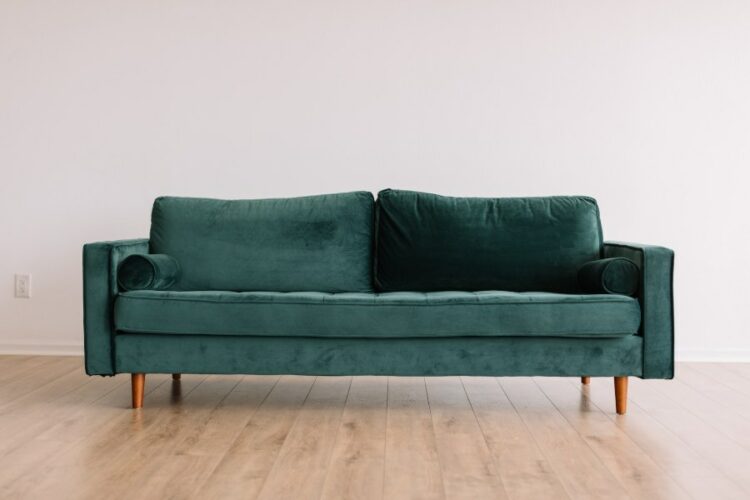Does your couch constantly slide around, causing frustration and discomfort? If so, you’re not alone. Many people face this common household issue but fear not, there are practical solutions to keep your couch firmly in place. This article aims to provide comprehensive guidance on how to prevent couch sliding effectively. Whether you have carpet, hardwood, or tiled floors, we’ll explore non-invasive solutions, furniture stabilization products, and DIY methods to ensure your couch stays put. Say goodbye to the annoyance of a sliding couch and enjoy a stable seating experience in your home!
How To Keep A Couch From Sliding?
There are several effective ways to keep a couch from sliding, depending on your preferences and the type of flooring you have. Here are some practical solutions:
- Anti-Slip Pads and Grippers: Place anti-slip pads or grippers under the couch legs to provide traction and prevent sliding on smooth surfaces.
- Rubber Feet and Stoppers: Attach rubber feet or stoppers to the bottom of the couch legs, which can grip the floor and prevent movement.
- Gripping Fabric and Non-Slip Mats: Use gripping fabric or non-slip mats between the couch and the floor to create friction and keep the couch in place.
- Furniture Straps and Tethers: Secure the couch to the wall or the floor using furniture straps or tethers to prevent any shifting.
- Furniture Brackets and Anchor Systems: Install furniture brackets or anchor systems to fasten the couch to the floor, especially useful on hardwood or tile floors.
- DIY Velcro Strips: Apply Velcro strips between the couch and the floor to add stability and prevent sliding.
- Tennis Balls or Furniture Coasters: Place tennis balls or homemade furniture coasters under the couch legs to limit movement on smooth floors.
- Adjust Furniture Legs: Check and adjust the couch legs regularly to ensure they are level and provide proper stability.
- Regular Cleaning and Maintenance: Keeping the floor and couch feet clean from dust and debris can improve traction and reduce sliding.
- Rearrange Furniture Placement: Consider positioning other furniture pieces strategically around the couch to create a barrier that keeps it from sliding.
Understanding The Causes Of Couch Sliding
Couch sliding can be a frustrating issue that disrupts the comfort and aesthetics of your living space. Understanding the causes of couch sliding is essential to find effective solutions. Several factors contribute to this problem. First and foremost, the type of flooring plays a significant role. Slippery surfaces like polished hardwood, tile, or laminate floors provide little friction for the couch legs, making it easier for the couch to move around. Additionally, the material of the couch itself can contribute to sliding. Smooth leather or fabric can glide more easily on certain surfaces, further exacerbating the problem.
Another factor is the construction of the couch. Lightweight couches with narrow legs are more prone to sliding, especially when occupied by multiple people or when someone sits or stands abruptly. The weight distribution in the seating area can shift, leading to unwanted movement. It’s also essential to consider the positioning of the couch in the room. Placing the couch near doors, windows, or high-traffic areas can increase the likelihood of sliding, especially if people tend to bump into it frequently.
Identifying the primary cause of your couch sliding is crucial for finding the most appropriate solution. By addressing the underlying factors, you can ensure a stable and secure seating experience, preventing unnecessary annoyance and potential safety hazards. In the next sections of this article, we will explore a variety of solutions to keep your couch firmly in place, tailored to different types of flooring and couch designs.
Furniture Stabilization Products
Furniture stabilization products offer robust solutions to prevent couch sliding and ensure a safe and secure seating experience. These products are specifically designed to anchor furniture pieces firmly in place, reducing the risk of accidents and improving overall stability. Here are some popular furniture stabilization products that can effectively keep a couch from sliding:
- Furniture Straps and Tethers: Furniture straps are heavy-duty nylon bands that can be attached to the back of the couch and secured to the wall or floor. These straps distribute the weight of the couch evenly and prevent it from tipping over or sliding, making them particularly useful for homes with small children or pets.
- Furniture Brackets and Anchor Systems: Furniture brackets are metal or plastic devices that connect the couch legs to the floor or wall. They provide strong support and prevent lateral movement, especially on hardwood or tiled surfaces. Anchor systems work similarly, using screws or adhesive to fix the couch to the floor or wall.
- Couch Grippers or Holders: Couch grippers are specialized anti-slip devices designed to grip the legs of the couch securely and prevent movement on slippery floors. They are usually made of rubber or silicone and provide excellent traction.
- Non-Slip Furniture Pads: Non-slip furniture pads are adhesive pads that can be attached to the bottom of the couch legs. They create friction with the floor, making it more difficult for the coach to slide around.
- Couch Clamps: Couch clamps are adjustable devices that connect two pieces of furniture together, such as a couch and a coffee table. By joining them, couch clamps can stabilize the entire seating area and prevent individual pieces from sliding apart.
Diy Solutions For Couch Stability
DIY solutions for couch stability are practical and budget-friendly options to keep your couch from sliding. These creative fixes can work well on various types of flooring and couch designs. Here are some DIY solutions you can try:
- Using Velcro Strips: Purchase industrial-strength Velcro strips from a hardware store. Attach one side of the Velcro to the bottom of the couch legs and the corresponding side to the floor. The Velcro will create a strong grip, preventing the couch from sliding on smooth surfaces.
- Tennis Balls or Furniture Coasters: Cut tennis balls in half and place one half under each leg of the couch. Alternatively, you can use small furniture coasters or pieces of thick rubber to achieve a similar effect. The rubbery texture will provide traction and keep the couch in place.
- DIY Non-Slip Mats: Cut a piece of rubberized shelf liner or rug pad to the size of your couch’s base. Place the liner or pad between the couch and the floor to increase friction and prevent sliding.
- Adhesive Rubber Pads: Purchase self-adhesive rubber pads commonly used for protecting floors from furniture scratches. Stick these pads to the bottom of the couch legs to create a non-slip surface.
- Furniture Stopper Wedges: Create stopper wedges using wood or thick cardboard. Place them under the front and back legs of the couch to keep it stable and prevent sliding.
- Bean Bags or Sandbags: Fill small bean bags or sandbags and place them strategically behind or under the couch. The added weight will help anchor the couch in place.
- Cork Pads: Attach cork pads to the bottom of the couch legs. Cork provides grip and is gentle on most flooring types.
Maintenance Tips For Preventing Sliding
Regular maintenance is crucial for preventing couch sliding and ensuring the longevity of your furniture. Here are some maintenance tips to keep your couch stable and secure:
- Clean the Floor and Couch Legs: Regularly sweep or vacuum the floor to remove dust, dirt, and debris that may reduce the friction between the couch legs and the floor. Similarly, clean the bottom of the couch legs to remove any built-up dirt or grime that could hinder the grip.
- Check and Tighten Screws and Bolts: Periodically inspect the couch frame and legs for loose screws and bolts. Tighten them as needed to maintain the structural integrity of the couch and prevent any wobbling or shifting.
- Reposition Furniture Pads or Grippers: Over time, furniture pads or grippers may shift due to movement or cleaning. Regularly check and reposition them to maintain their effectiveness.
- Replace Worn-Out Pads: If you notice that the furniture pads or grippers are becoming worn or losing their grip, replace them with new ones to ensure optimal performance.
- Reevaluate Couch Placement: If your couch continues to slide despite using various methods, consider repositioning the couch in the room. Placing it against a wall or between other furniture pieces can help create a more stable seating arrangement.
- Use Slipcovers or Furniture Blankets: Adding slipcovers or furniture blankets to the couch can provide an additional layer of grip between the couch and the floor, reducing sliding.
- Regularly Inspect Stabilization Products: If you’ve used furniture stabilization products, such as straps or brackets, inspect them regularly to make sure they are still secure and functioning correctly.
Final words
With these practical solutions and maintenance tips, you can bid farewell to the frustration of a sliding couch. Keeping your couch stable and secure is essential for a comfortable seating experience and a safer living space. Whether you opt for non-invasive methods, furniture stabilization products, or DIY fixes, remember to tailor your approach to your specific flooring and couch design. Enjoy a stable and worry-free couch that stays firmly in place!
FAQ’s
Why Does My Couch Keep Sliding On Hardwood Floors?
Smooth hardwood floors offer little friction, causing the couch legs to slide easily. The weight distribution of the couch and its lightweight construction can also contribute to the problem.
Are Furniture Grippers Suitable For All Types Of Flooring?
Furniture grippers work well on hardwood, tile, laminate, and vinyl floors. However, they may not be as effective on thick carpeting, where other solutions like non-slip rug pads are more appropriate.
Can I Use Velcro Strips To Prevent The Couch Sliding On The Carpet?
Velcro strips might not adhere well to carpet fibers, making them less effective on carpeted floors. Consider using non-slip rug pads or other carpet-specific solutions.
Can I Make My Own Furniture Stabilization Products?
Yes, DIY furniture stabilization products like Velcro strips, rubber pads, or stopper wedges can be effective. However, for heavy or valuable furniture, consider using professionally designed furniture straps and anchors for added safety.







